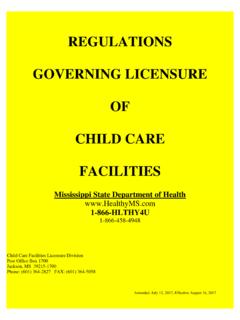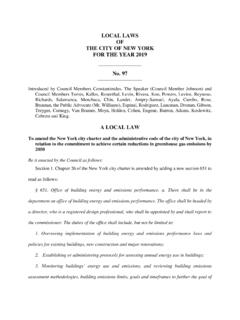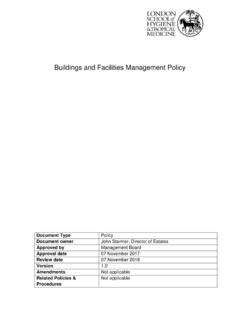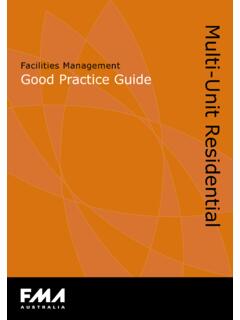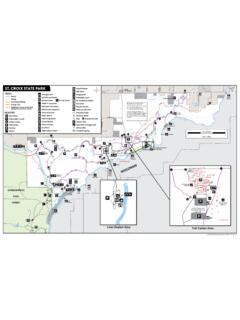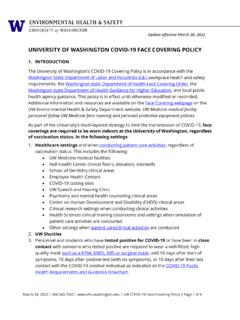Transcription of Developing a Water Management Program to Reduce …
1 June 24, 2021 Ve r s ion a Water Management Program to Reduce Legionella Growth & Spread in BuildingsA PRACTICAL GUIDE TO IMPLEMENTING INDUSTRY STANDARDSiiForewordLegionnaires disease is a serious type of pneumonia caused by bacteria, called Legionella, that live in Water . Legionella can make people sick when they inhale contaminated Water from building Water systems that are not adequately maintained. Unfortunately, Legionnaires disease is on the rise in the United States. To reverse this trend, we are asking for your help to manage the risk of exposure to Legionella from Water in your building. Your building may need a Water Management Program to Reduce the risk for Legionnaires disease associated with your building Water system and devices. This Water Management Program should identify areas or devices in your building where Legionella might grow or spread to people so that you can Reduce that risk.
2 Legionella Water Management programs are now an industry standard for large buildings in the United States (ASHRAE 188: Legionellosis: Risk Management for Building Water Systems June 26, 2015. ASHRAE: Atlanta). This toolkit will help you develop and implement a Water Management Program to Reduce your building s risk for growing and spreading Legionella. If you already have a Program , this toolkit will help you assess and strengthen it. Included are practical resources to help you ensure that your Water Management Program is comprehensive, effective, and in line with industry standards. This toolkit also highlights special considerations for healthcare building Water systems vary in their design and complexity, examples in this toolkit are only meant to help you understand the process. You should develop a Water Management Program to Reduce Legionella growth and spread that is specific to your the United States, reported cases of Legionnaires disease have increased by nearly four and a half times since 2000.
3 More illness occurs in the summer and early fall but can happen any time of *Natio nal Notifiable Dis ease Surveillance SystemIncidence (c ases/100,000 pop.)Legio nnaires Disease Is On t he Rise2000 2018*We welcome your feedback on this toolkit by emailing additional information about Legionnaires disease, visit toolkit can also be found online at Messonnier, MD, CAPT USPHSD irector, National Center for Immunization and Respiratory Centers for Disease Control and PreventionPatrick Breysse, PhDDirector, National Center for Environmental Health/Agency for Toxic Substances and Disease Centers for Disease Control and Prevention iiiTable of ContentsForeword ..iiHow to Use This toolkit ..1 Identifying Buildings at Increased Risk ..2 Glossary ..3 Introduction to Legionella Ecology ..4 Elements of a Water Management Program .
4 6 Establish a Water Management Program Team ..7 Describe Your Building Water Systems Using Text ..8 Describe Your Building Water Systems Using a Flow Diagram ..10 Identify Areas Where Legionella Could Grow & Spread ..11 Control Measures & Corrective Actions: The Basics ..12 Decide Where Control Measures Should Be Applied ..13 Decide How to Monitor Your Control Measures ..14 Establish Ways to Intervene When Control Limits Are Not Met ..15 Corrective Action Examples ..15 Contingency Response Examples ..18 Make Sure the Program Is Running as Designed & Is Effective ..21 Document & Communicate All the Activities of Your Water Management Program ..22 Special Considerations for Healthcare facilities ..23 Elements of a Water Management Program ..23 Identifying & Investigating Legionnaires Disease Cases ..24 References & Resources.
5 26 Appendix A ..29 Appendix B ..301 How to Use This ToolkitIf you ve never developed a Legionella Water Management Program (a plan to Reduce the risk of Legionella growth and spread), you might not be sure where or how to start. This toolkit will provide guidance to help you develop, implement, and evaluate a Legionella Water Management Program for your building. You do not have to have training or certification in any specific hazard analysis, risk assessment, or risk Management methodologies to use this toolkit . However, you may need to seek help from an expert in some cases. Be sure to follow all relevant federal, state, and local laws, regulations, and ordinances. If anything in this toolkit conflicts with these policies, always adhere to the policies. Where do we start?The first step is to determine if you even need a Program .
6 You can use the worksheet on page 2 to find out if your entire building or parts of it are at increased risk for Legionella growth and spread. If you learn that you need to develop a Program , this toolkit will explain what steps you should take and give several examples to clarify the we really need a Water Management Program to prevent Legionella growth and spread?If you answer YES to any of the questions on page 2, then yes! Developing and implementing a Program means that you are helping to protect people from getting Legionnaires disease, a serious type of pneumonia (see Appendix A for more information on this disease). Is this toolkit full of scientific terms?You might come across some technical terms that are unfamiliar. The glossary on page 3 and the introduction to Legionella ecology on pages 4 5 should help you with these this toolkit tell us everything that we need to do?
7 No. Because every building is unique, only you have access to all the information that is needed to develop and implement a Program specific to your building. An example of a building is included to help illustrate some of the steps. It s important to know that these examples are not comprehensive and you will need to create a Program specific to your building Water system and toolkit looks really long. What s the bottom line?You need to actively identify and manage hazardous conditions that support growth and spread of Legionella. As you work through the toolkit , you ll learn about the importance of identifying and controlling hazardous conditions that increase the chance of Legionella growth and spread. The bottom line is that you need to: Identify building Water systems for which Legionella control measures are needed Assess how much risk the hazardous conditions in those Water systems pose Apply control measures to Reduce the hazardous conditions, whenever possible, to prevent Legionella growth and spread Make sure the Program is running as designed and is effectiveIs there anyone who can help us develop our Program ?
8 Yes. As you ll learn in the toolkit , it s recommended that you form a Water Management team. Your team should include a variety of people who bring different skills to the table (learn more on page 7). You might already have all the expertise you need on staff, but sometimes you will need to get outside help. In some cases, you may need to train your in-house personnel or hire professionals with specific experience in Legionella bacteria in building Water systems, such as a certified industrial hygienist, a microbiologist, or an environmental health specialist. Blueprints could come in handy, do all of the gray boxes mean?The gray boxes throughout the document highlight Program elements that are especially relevant for healthcare facilities . The content found outside of the gray boxes is also applicable to these types of facilities .
9 Reference: ASHRAE 188: Legionellosis: Risk Management for Building Water Systems June 26, 2015. ASHRAE: Atlanta. A LEGIONELLA Water Management PROGRAMI dentifying Buildings at Increased RiskSurvey your building (or property) to determine if you need a Water Management Program to Reduce the risk of Legionella growth and you answer YES to any of questions 1 through 4, you should have a Water Management Program for that building s hot and cold Water distribution system. Healthcare FacilitiesYes ____ No ____ 1. Is your building a healthcare facility where patients stay overnight or does your building house or treat people who have chronic and acute medical problems or weakened immune systems?Yes ____ No ____ 2. Does your building primarily house people older than 65 years (like a retirement home or assisted-living facility)?
10 Yes ____ No ____ 3. Does your building have multiple housing units and a centralized hot Water system (like a hotel or high-rise apartment complex)?Yes ____ No ____ 4. Does your building have more than 10 stories (including basement levels)?Devices in buildings that can spread contaminated Water droplets should have a Water Management Program even if the building itself does not. If you answer NO to all of questions 1 through 4 but YES to any of questions 5 through 8, you should have a Water Management Program for that ____ No ____ 5. Does your building have a cooling tower*?Yes ____ No ____ 6. Does your building have a hot tub (also known as a spa) that is not drained between each use?Yes ____ No ____ 7. Does your building have a decorative fountain?Yes ____ No ____ 8. Does your building have a centrally-installed mister, atomizer, air washer, or humidifier?










